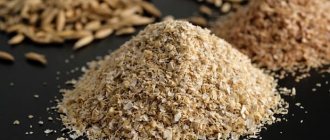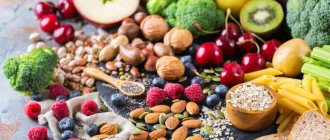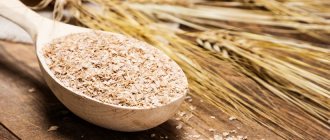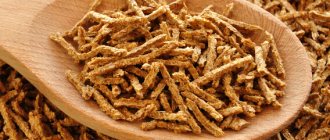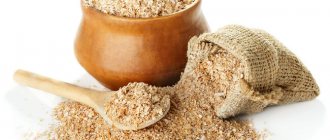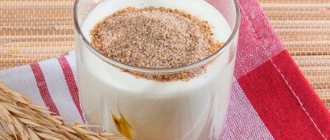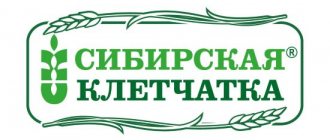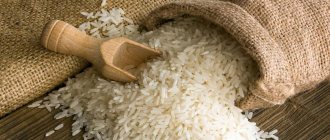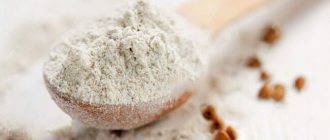Fiber and bran: are they the same thing or not?
Those who try to lead a healthy lifestyle and eat right know how important dietary fiber is for the body. Their main sources, fiber and bran, are considered by many to be one and the same product.
But this opinion is wrong. Both ingredients are extracted from plants and provide similar benefits to the body, but there are differences between them. Fiber is just one of the components of bran.
What is fiber
Cellulose is a polysaccharide. In its purified form, it is a carbohydrate without any foreign impurities. However, in practice it is not so highly refined, so it contains other compounds (proteins, fatty acids) in small quantities.
The substance is included in the group of dietary fibers, since a significant part of it is not absorbed by the body. Only a small proportion of cellulose derivatives (soluble fiber) is broken down.
The main benefits of dietary fiber:
- activation of intestinal function;
- cleansing the body of waste and toxins;
- reducing the feeling of hunger due to swelling in the stomach.
These substances are found in all plants in varying quantities. Cereals and legumes, vegetables, herbs, fruits are rich in them, and they are also found in nuts.
Fiber and bran for weight loss. What is the difference?
Feeling full. When eating bran, the feeling of fullness comes faster and remains for a long period. This is a great helper for reducing the calorie content of dishes. The bran itself contains about 200 calories per 100 grams. The calorie content of fiber is 35 kcal per 100 grams. This is another fact how fiber differs from bran.
Nutritional value. Fiber itself does not contain any nutrients. And bran carries nutritional value in the form of proteins, fats and carbohydrates. One tablespoon of bran contains only 12-22 calories. And this amount will be enough to reduce appetite and slow down absorption in the intestines.
A tablespoon contains bran:
- 15 grams of oats;
- 20 grams of wheat;
- 25 grams of rye.
The daily recommended dose is 30 grams. This will be enough to saturate the body with useful substances.
Availability of vital nutrients. When considering the question of what is the difference between fiber and bran, it is necessary to mention the presence of such vitamins and microelements in bran as:
- B1-thiamine;
- B2 – riboflavin;
- B3 – niacin;
- B5 – pantothenic acid;
- B6 – pyridoxine;
- E – tocopherol, provitamin A;
- vitamin K;
- calcium, magnesium; folic acid;
- iron, zinc;
- phosphorus, potassium.
Diabetic product. For people suffering from diabetes, you need to know the difference between fiber and bran. Not all fruits containing fiber are suitable for diabetics. But bran is an excellent remedy for replenishing its deficiency in the body. They also reduce the rate of breakdown of starches, which helps lower blood sugar levels. That is, bran affects the glycemic index of foods.
Choleretic effect. For people with diseases of the biliary tract, pancreas, bile stagnation, and liver dysfunction, the use of bran is especially necessary. Due to mechanical stimulation, the natural movement ability of the digestive tract is ensured. This fact is very important when studying the question of what is the difference between fiber and bran. Fiber does not have the same choleretic effect as bran.
What is the difference between fiber and bran?
Many plants can be a source of fiber; it is included in a large list of products, including as a thickener, and is sold as a dietary supplement and for weight loss.
Bran is made from grain, it is sold in its pure form or enriched baked goods and cereals. They are not found in other foods.
Well-purified cellulose will have an energy value of about 40 kcal per 100g. But supplements with a calorie content of 150-170 kcal are more often found on sale.
Crushed shells with germ are a complex of compounds; they always contain protein and fats in varying quantities, which depends on the raw material. Therefore, their calorie content per 100 g is higher and is approximately 250 kcal for wheat and 350 kcal for oatmeal.
This is a more nutritious and valuable component. The “waste” from flour production includes up to 80% fiber, so to achieve an effect on dietary fiber, you need to eat more of it.
The main common property of these food additives is that they swell in water, increase in size and create a feeling of fullness. In addition, as sorbents, they remove cholesterol and many harmful substances from the body. But bran is also a supplier of nutrients.
Benefits of bran
Bran is 4/5 fiber, so in many ways the effect of these products will be similar. However, it is worth considering that the composition of microelements, calorie content, protein, carbohydrate and fat content largely depends on the raw materials, the original grain. They will be different for wheat, rice, rye and oat bran.
Latest entries The best models of sneakers for all occasions: a review of trending brands, their new products and proven flagships Summer trousers 2021: choosing trendy colors, styles and fabrics Fashionable clothing styles: trends 2021-2022 for women, men and children of any age and body type
Benefits of bran:
- purgation;
- normalization of digestion;
- creating a feeling of satiety;
- decreased appetite.
To lose weight, nutritionists recommend taking oat bran. They are optimal in their content of nutrients and are best suited for weight loss. Consume no more than 50 g per day and drink plenty of water!
Which bran has the most fiber?
The cellulose content in grain shells varies greatly depending on the raw materials from which they are obtained and ranges from 15 to 80%. Wheat ones are optimal for several reasons.
This is the most common option. They have a rich composition, include many B vitamins, and are easy to digest.
The record holders for carbohydrate content are the by-products of corn processing, but you shouldn’t buy flax for these substances: they simply aren’t there.
How much fiber is in bran by type is presented in the table:
| Variety of grain hulls | Dietary fiber, g per 100 g | Dietary fiber in 1 tablespoon (15 g) |
| Corn | 80 | 12 |
| Rye | 45 | 6,8 |
| Wheat | 43-45 | 6,5-6,8 |
| Rice | 20 | 3 |
| Oatmeal | 15 | 2,3 |
| Linen | Do not contain | Do not contain |
1 tablespoon contains approximately 15 g of bran. The exact weight depends on their degree of grinding (12 g for coarse and up to 20 g for fine).
What is the difference
Fiber is a general term meaning plant fibers that are found in plant foods, including bran. It is not absorbed by the body, but passing through the digestive system, cleanses it and removes harmful substances from it. Bran is 80% fiber. It is a by-product of the production of flour from various grains. The remaining solid parts of the grain contain microelements and vitamins beneficial to the body. When used correctly, they help prevent various diseases and remove excess weight.
Food and drinksComment
Which is healthier?
It all depends on what goals a person pursues:
- If you need to saturate your body with nutritional components, then it is definitely better to purchase bran. With a stable weight, they can be included in baked goods, added to porridge, and prepared in cocktails. From a nutritional point of view, this product is much healthier.
- If the main goal is cleansing the intestines and losing weight, then you should give preference to fiber. It is lower in calories and needs to be eaten in smaller quantities.
You can first practice a diet using cellulose, and after getting rid of extra pounds, switch to eating crushed shells.
Oat bran fiber for the gastrointestinal tract
Fiber from oat bran is necessary for the functioning of the digestive system and is effective for the prevention of cancer.
Fiber, with its porous structure, is capable of holding a large amount of water (1 g holds 5 g of water), and when it enters the intestine it helps to dilute the stool, as well as actively move it through the colon. It is thanks to this feature that oat bran fiber is useful for people suffering from constipation.
Fiber serves as an excellent nutrient medium for beneficial intestinal microflora. Thanks to the intake of oat bran fiber, dysbacteriosis is treated.
B vitamins (B1, B2, B3) are excellent for digestion; they promote the secretion of gastric juice and enhance the activity of the liver and pancreas.
Oat bran fiber normalizes the process of bile secretion and absorbs “bad” cholesterol, so it is recommended to eat it regularly.
It perfectly cleanses the stomach, which is the key to health and longevity. Daily consumption of 20-30 g of fiber prevents the formation of polyps in the rectum.
In Rus', steamed bran has long been used in folk medicine, as a laxative to normalize digestion, for poisoning, and as an emollient for psoriasis, eczema, and dry skin. Nowadays, oat bran fiber is used in cosmetology to prepare masks for aging facial skin.
What's best for losing weight?
To lose weight, you should choose pure fiber. It should be introduced into the diet in small portions, constantly increasing the amount to 25 g per day.
There is no need to chew it dry. The substance is mixed with water, kefir or juices. It can be added to soups and porridges.
Read more about how to take fiber for weight loss by following the link.
How to take bran
Due to the presence of coarse fibers, grain shells stimulate the intestines, they act as food for beneficial bacteria, and therefore help with constipation. They are consumed no more than 2 tablespoons per day, but you should start with 1 teaspoon.
To facilitate bowel movements, it is useful to drink bran diluted in a glass of kefir or yogurt.
During administration, it is important to maintain a drinking regime and consume at least 2 liters of water.
For other ways to take bran and what you can cook with it, read the link.
// Fiber - what is it?
Fiber is a type of complex carbohydrate. Essentially, it forms the structure of vegetables and is also a material for the coating of grains. There is a lot of dietary fiber in bran, cereals, grains, nuts, any vegetables and fruits - you will find detailed tables further in the material.
Although fiber is not absorbed by the body, it ensures the movement of food through the intestines and improves its microflora¹. The advantage of fiber products is their low glycemic index - their regular consumption helps maintain stable blood sugar levels.
Soluble fiber, found in fruits and a number of other foods, turns into a gel-like substance in the stomach - serving as food for beneficial bacteria. In turn, coarse insoluble fiber improves digestive mechanics.
// Fiber - briefly:
- dietary fiber found in plants
- necessary for digestive processes
- acts as a prebiotic
// Read more:
- complex carbohydrates - what are they?
- glycemic index of cereals
- soluble fiber - food list
Daily norms
On average, the daily fiber intake for adults is 30 g, for children - 20-25 g¹. Athletes on a muscle-building diet need up to 40 grams of fiber per day (due to higher caloric intake)².
In addition, when following a diet for weight loss (especially in the case of low-carb and no-carb diets), it is extremely important to ensure that fiber-rich foods are always preserved in the diet - otherwise digestive problems may arise. // Read more:
// Read more:
- How exactly does fiber affect weight loss?
- low-carbohydrate diet - what is it?
- keto diet - example menu by day
Is it possible to replace bran with fiber?
There will be no harm to the body if you eat cellulose instead of grain shells. But this is not a full-fledged replacement; it can only be practiced on fasting days.
If we are talking about a long-term diet, then such a substitution cannot be carried out. After all, these products have completely different chemical compositions, and their main difference is their energy value. If you replace it 1:1, then the body will not receive the required amount of calories.
In addition, individual nutrition systems specify not just grain shells, but a specific product. For example, the Dukan diet insists on oat bran.
What is fiber and what foods contain it?
If we take the scientific definition of the term, then fiber is food components that are not digested by the digestive enzymes of the human body, but are processed by beneficial intestinal microflora.
The second name used in the food industry is dietary fiber.
Previously, it was called a ballast substance, until the important functions that it performs in the human body were discovered.
Usually at this point, they begin to tell you how useful it all is and give you lists of products and dosage regimens. But this is not my method. Until we fully understand this substance, I will not leave you alone.
Fiber is a substance that is found in plant foods and only in them. It is essentially a fibrous structure that forms the shell of plants.
Once in the digestive system, this structure is not affected by enzymes and goes through the entire journey unchanged.
If so, does it mean that it does not have any energy value and can be consumed in any quantity without any side effects on the body? Theoretically, this is true. But, as always, there is a “But”.
Fiber (dietary fiber) comes in two types: soluble and insoluble. This is a fundamental point that is important to understand, so I will dwell on it in more detail.
Soluble dietary fiber
Hemicellulose, gums, pectins are soluble dietary fibers, as the name implies, capable of absorbing liquid. Due to this, in the intestines they turn into a gel-like substance, which slows down the movement of the contents and slows down the enzymatic processing of carbohydrates. Slowing down the processing of carbohydrates is precisely the point that prevents a sharp release of glucose into the blood. Therefore, when you read that porridge is a “slow” carbohydrate that does not significantly increase blood sugar levels, this is precisely due to the presence of soluble dietary fiber.
Contains:
- legumes (peas, beans, beans, lentils),
- grains (oats, rye, barley),
- some fruits (prunes, raisins, avocados, berries, bananas, peels of apples, quinces and peaches).
Hemicellulose absorbs water, facilitating colon activity. Essentially, it “bulks” waste and moves it through the colon faster. This not only prevents constipation, but also protects against diverticulosis, spasmodic colitis, hemorrhoids and varicose veins.
Gums and pectin affect absorption processes in the stomach and small intestine. By binding to bile acids, they reduce fat absorption and lower cholesterol levels. They delay gastric emptying and, by coating the intestines, slow down the absorption of sugar after meals, which is useful for diabetics, as it reduces the required dose of insulin.
Insoluble dietary fiber
Lignin and cellulose are insoluble fibers that do not perceive any impact and pass through the gastrointestinal tract without changes. They accelerate the movement of food contents through the gastrointestinal tract and have a laxative effect (used to prevent constipation). They are prebiotics (restore microflora).
Contains:
- bran (remember this),
- unprocessed grains,
- legumes,
- nuts,
- seeds,
- green beans,
- cauliflower,
- broccoli,
- greenery,
- peel of fruits and vegetables.
Lignin reduces the absorption of other fibers. In addition, it binds to bile acids, helping to lower cholesterol levels and speeds up the passage of food through the intestines.
Benefits and harms
Well, now we can draw conclusions.
Fiber is a product that is very desirable when losing weight. Thanks to products rich in it, you will get several advantages at once:
- reduction of hunger without extra calories (conventional calorie content of fiber 35 kcal/100 grams),
- ensuring normal functioning of the gastrointestinal tract,
- slowdown in the absorption of proteins, fats and carbohydrates,
- filling the stomach, reducing appetite and reducing the size of food portions.
And of the negative points, I can name only one:
- its excessive consumption leads to heaviness in the stomach and bloating
The feeling is not pleasant, so remember to limit the amount you consume. Doctors recommend consuming 35 to 50 grams of pure substance per day. To get this amount you need to eat:
- 3 medium fruits (apple, pear, orange)
- 100 grams of fresh vegetables
- 4 slices wholemeal bread
- 30 grams of legumes (beans, peas, corn) or nuts
Hmm, some dieters have a daily ration less than what is listed.
In fact, it's quite difficult to keep track of all this unless you keep a food diary. Therefore, the simplest, but no less effective way is to buy ready-made fiber.
There are hundreds of options to choose from. You can buy it at any supermarket or pharmacy. It is sold in bags and in cans, 200 grams and 1 kilo. Everyone will find what is convenient for them.
The source of the finished product is traditionally legumes and grains, but you can also find fiber extracted from the bark of trees or herbaceous plants. This does not affect the meaning, only the price.
Eating ready-made fiber is a simple process: eat one heaped tablespoon three times a day, washed down with water or added to kefir or drinking yogurt. This option is very convenient as a snack when you feel hungry.
During heat treatment of fresh vegetables and fruits, half of the fiber is lost due to the destruction of its fibrous structure
Well, I think I’ve said everything about fiber, let’s move on to bran.
